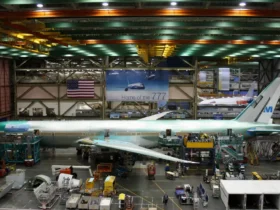Japan’s naval strategy is about to make a significant leap as one of its “heavily modified” aircraft carriers, the JS Izumo, heads to the United States to conduct tests for F-35B short takeoff and vertical landing (STOVL) operations. This move comes at a critical time, amid escalating tensions in the Indo-Pacific region. The deployment, which was reported on September 9, 2024, marks a notable development in Japan’s efforts to enhance its defense capabilities and align more closely with the U.S. military, especially as the geopolitical landscape in the region grows more volatile.
The JS Izumo, originally commissioned as a helicopter destroyer, has undergone extensive modifications to serve as a platform for the F-35B STOVL fighter jets. These modifications include strengthening the flight deck to withstand the intense heat generated by the jet’s exhaust, installing landing lights, and applying heat-resistant coatings. The aircraft carrier is now headed to U.S. waters to carry out tests that will determine the full compatibility of the F-35B fighters with the carrier’s new configurations. This exercise is crucial for Japan, as it aims to verify that the modifications meet the required standards for operational deployment, particularly in light of the increasing military activity by China and North Korea in the region.

Japan’s decision to deploy the JS Izumo to the U.S. underscores the nation’s growing concern over the Indo-Pacific security environment. The region has been witnessing heightened military maneuvers, including frequent incursions by Chinese naval and air forces near Japanese waters. Additionally, North Korea’s continued missile tests and the assertive posturing by other regional players have contributed to an atmosphere of unease. For Japan, enhancing its aircraft carrier capabilities with the state-of-the-art F-35B fighters is seen as a critical step in countering these threats and maintaining a strategic balance.
The F-35B jets, known for their advanced stealth capabilities and flexibility in combat scenarios, represent a significant upgrade for the Japanese Self-Defense Forces. The STOVL operations allow these jets to take off from shorter runways, which is ideal for Japan’s maritime environment, characterized by numerous small islands and limited space for airbases. This capability is crucial in potential conflict scenarios where conventional airfields might be compromised or targeted. By testing these operations in U.S. waters, Japan aims to ensure its new carrier-air wing integration is seamless and fully capable of responding to any regional threats.
This cooperation with the U.S. also highlights the deepening defense ties between the two nations. Japan and the U.S. have been strengthening their military alliance, with both countries expressing concern over the rapid militarization of the Indo-Pacific by China. The U.S. views Japan as a critical ally in maintaining stability and ensuring freedom of navigation in this strategically vital region. The JS Izumo’s upcoming tests in U.S. waters are expected to involve joint training exercises with the U.S. Navy, providing both forces an opportunity to enhance interoperability and operational readiness.
For Japan, this is not just about military upgrades but also a significant step in demonstrating its commitment to regional security. Japan’s post-World War II constitution limits its military’s scope, emphasizing a defensive posture. However, with rising threats and changing dynamics in the Indo-Pacific, Japan has gradually shifted towards a more proactive defense strategy. The decision to transform its helicopter destroyers into aircraft carriers capable of launching and recovering the F-35B jets reflects this shift. It also marks a historic moment for Japan, as these modifications represent its first step back into the realm of fixed-wing carrier operations since World War II.
China has already responded to this move with caution. Beijing has voiced concerns over Japan’s increasing military capabilities, viewing them as a potential threat to its interests in the South China Sea and East China Sea. Chinese state media have accused Japan of militarizing the region and attempting to shift the balance of power in the Indo-Pacific. However, Japan maintains that these upgrades are purely defensive and aimed at protecting its sovereignty and maintaining peace and stability in the region.

The deployment of the JS Izumo to the U.S. also sends a message to other regional players, particularly North Korea. Pyongyang’s frequent missile tests have rattled Japan and other neighboring countries. By enhancing its aircraft carrier capabilities, Japan aims to bolster its deterrent posture against potential aggressors. The tests with the F-35B are expected to be closely monitored by North Korea, which views any increase in Japanese military capability with suspicion.
As the JS Izumo heads to the U.S., it symbolizes Japan’s broader defense strategy in the face of a rapidly evolving security environment. It reflects a commitment to adapting its forces to new challenges and reaffirming its role as a key player in maintaining regional stability. The successful integration of the F-35B jets onto the JS Izumo will not only enhance Japan’s defensive posture but also signal to the world that it is prepared to meet the challenges of a turbulent Indo-Pacific head-on.
The coming weeks will see a series of tests and exercises aimed at ensuring the F-35B operations run smoothly on the newly modified carrier. For Japan, this is about more than just military hardware; it’s a statement of intent, reflecting its readiness to defend its interests and support its allies amid a complex and uncertain regional landscape. The world will be watching closely as Japan moves forward with these pivotal trials, which could shape the future of naval aviation and defense in the Indo-Pacific.









Leave a Reply